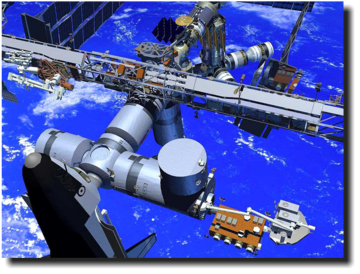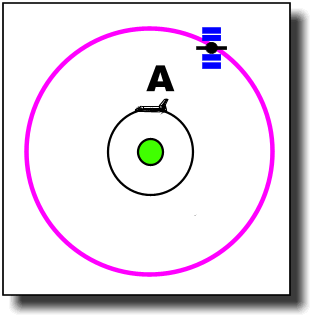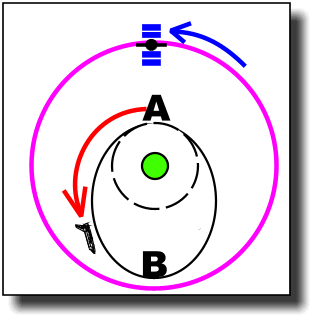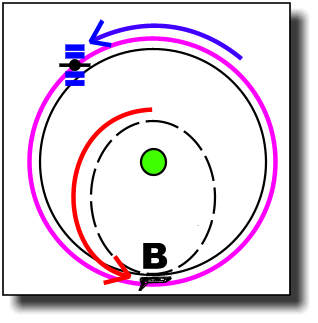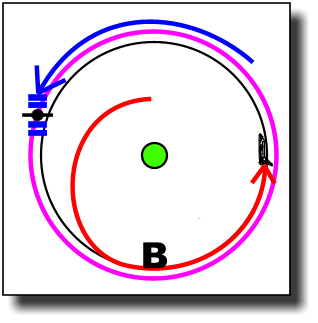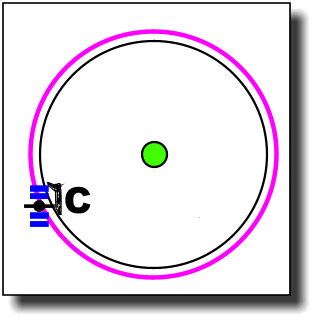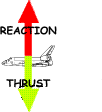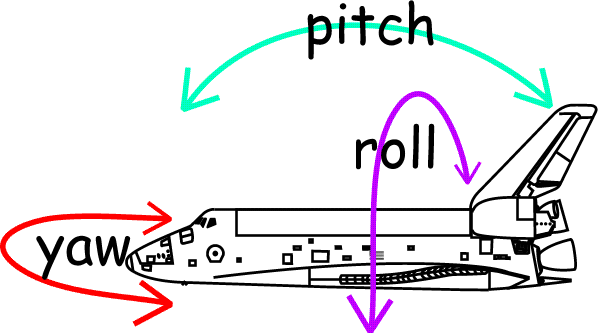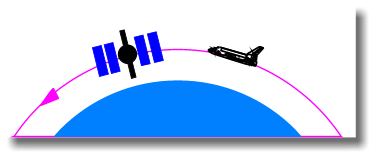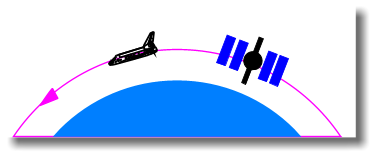ISS07: iss07.yesican-science.ca
|
||||||||||||||||||||||
Docking with the ISS |
||||||||||||||||||||||
| When Space Shuttle pilots dock their craft to the ISS, their accuracy has to be precise; there is no room for miscalculation.
Image courtesy of NASA, looking down on the Shuttle Orbiter (lower left foreground), docked to the International Space Station. The Earth (Pacific Ocean), is below. Note: The diagrams below illustrate the initial and final orbital paths taken by a spacecraft which is initially in a circular orbit in the plane of the Earth’s equator. The diagrams are seen looking down on the Earth’s North Pole. Scales are exaggerated for purposes of illustration. The solid lines indicate the new orbit path, the dashed lines indicate the original orbital configuration attained after the rocket burn indicated. |
||||||||||||||||||||||
| Docking the Space Shuttle, or any other spacecraft, to the International Space Station (ISS) requires that the orbit of the spacecraft intersect the orbit of the ISS. It is also a requirement that the relative velocities of the two spacecraft at their point of intersection be quite small, (otherwise a collision would ensue).
Of course timing is essential also … the ISS and the spacecraft must be at their orbital intersection point simultaneously. To accomplish this feat requires some careful planning and several rocket “burns”. Consider the International Space Station in a circular orbit around the Earth and the Space Shuttle in a similar orbit, but at a lower altitude, as shown in the illustration below. We will also assume that in this case both orbits lie in the same plane.
|
||||||||||||||||||||||
| The first step in performing the docking manoeuvre is to put the Shuttle into approximately the same orbit as the ISS.
The rocket engines are briefly fired (point A on the illustration below), to increase the forward velocity of the Shuttle. This transforms the Shuttle’s circular orbit to an elliptical orbit. The apogee of this elliptical orbit (furthest point from the Earth), is at approximately the same altitude as the orbit of the ISS. The perigee (closest point to the Earth), occurs at the same point in the orbit where the rocket engines where fired.
|
||||||||||||||||||||||
| In order to match the orbit of the ISS, the Shuttle’s orbit must be circularized. This is accomplished by performing a second rocket “burn” at the apogee of the elliptical orbit, labelled B in the diagram below.
The projected circular orbit is the thin line slightly inside the orbit shown for the Space Station. The Shuttle’s orbital period will be slightly less than the orbital period of the ISS. This causes the Shuttle to gradually close-in on the Space Station.
|
||||||||||||||||||||||
| The slightly smaller circular orbit of the Shuttle path causes it to gain on the International Space Station from an altitude slightly below it.
Although the path taken by the Shuttle in this illustration appears to occur within a single orbit, it generally takes many orbits to manoeuvre the Shuttle to within docking distance of the Space Station. The rendezvous and the docking take the form of a series of successively smaller orbit adjustments, each manoeuvre “fine-tuning” their orbital paths until convergence is achieved. The docking speed of the Shuttle with respect to the International Space Station is several centimetres per second.
|
||||||||||||||||||||||
| It is important to realize that docking is achieved by orbital manoeuvring, and not by direct translation from one point to another.
In the illustration used here the Shuttle has been in the lower orbit and thus had the speed advantage, so it gradually closed in on the ISS from behind. It is equally possible to put the Shuttle into a slightly higher orbit, in which case the ISS would have the orbital speed advantage and it could be allowed to converge on the Shuttle.
|
||||||||||||||||||||||
| The Shuttle is able to manoeuver in six possible ways in order to change its orbit, two in each dimension, up-down, left-right, forward and backward. Each of these manoeuvers modifies the orbit of the shuttle.
Note: In the diagrams below
|
||||||||||||||||||||||
|
||||||||||||||||||||||
| In addition, combinations of these can change the orbital attitude of the shuttle without significantly changing its orbit. The attitude of the spacecraft is its orientation with respect to some specified frame of reference such as the fixed stars, or the earth’s surface directly beneath the spacecraft. Attitude manoeuvers are called pitch (nose up or nose down), roll ( wing tips up and down), and yaw (nose rotated left or right).
|
||||||||||||||||||||||
Blog It!Try your hand at solving these problems. Write a new blog entry describing your solutions. Please check the Getting to and from the ISS topics box before posting. Remember to come back often and compare your solutions with those of other students!
|
||||||||||||||||||||||
